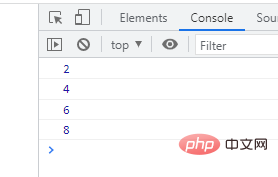Does continue jump out of the current loop or all loops?
continue is to jump out of the current loop. The continue statement is used to skip this loop and execute the next loop; when encountering the continue statement, the program will immediately recheck the conditional expression. If the expression result is true, the next loop will start. If the expression result is false, Exit the loop.

The operating environment of this tutorial: windows7 system, javascript version 1.8.5, Dell G3 computer.
continue statement
The continue statement is used to skip this loop and execute the next loop. When encountering a continue statement, the program will immediately re-test the conditional expression. If the expression result is true, the next loop will start. If the expression result is false, the loop will exit.
[Example 1] Use the continue statement to jump out of the for loop:
<script type="text/javascript">
for (var i = 1; i < 10; i++) {
if(i % 2 != 0) {
continue;
}
console.log(i);
}
</script>Analysis:
for (var i = 0; i < ; 10; i ){}The statement can be used to loop through all numbers between 1 and 10if(i % 2 != 0)The statement is used to determine whether the value of i is divisible by 2. If it cannot be divisible, if the value in()is true, thecontinue;statement will be executed.In the loop body, use the
if(i % 2 == 0)statement to determine if the value ofican be divided by 2 Just use "console.log(i);" to output; if the value oficannot be divided evenly by 2, thecontinue;statement will be triggered to jump out of this loop ( No output), execute the next cycle.
Output result:

Extended knowledge: break statement
The break statement is used to jump out of the current syntax structure. It can terminate the code of the loop body and jump out of the current loop immediately, executing the code after the loop (if any).
The difference between break and continue is that the continue statement only ends the current loop, while the break statement terminates the execution of the entire loop.
Use the code in Example 1 above and replace continue; with break;. What will be output?
<script type="text/javascript">
for (var i = 1; i < 10; i++) {
if(i % 2 != 0) {
break;
}
console.log(i);
}
</script>The answer is: Nothing is output. Why is this happening? Let’s analyze it:
At the beginning of the forx loop, i=1, is 1 less than 10? Of course, then start executing the if(i % 2 != 0) statement in the loop body;
So can 1 be divided by 2? Obviously it cannot, so if the value in () is true, then the "break;" statement in the if is executed, jumping out of the entire loop directly, and there is no chance to execute "console .log(i);" statement.
The above is the detailed content of Does continue jump out of the current loop or all loops?. For more information, please follow other related articles on the PHP Chinese website!

Hot AI Tools

Undresser.AI Undress
AI-powered app for creating realistic nude photos

AI Clothes Remover
Online AI tool for removing clothes from photos.

Undress AI Tool
Undress images for free

Clothoff.io
AI clothes remover

AI Hentai Generator
Generate AI Hentai for free.

Hot Article

Hot Tools

Notepad++7.3.1
Easy-to-use and free code editor

SublimeText3 Chinese version
Chinese version, very easy to use

Zend Studio 13.0.1
Powerful PHP integrated development environment

Dreamweaver CS6
Visual web development tools

SublimeText3 Mac version
God-level code editing software (SublimeText3)

Hot Topics
 1378
1378
 52
52
 What is useEffect? How do you use it to perform side effects?
Mar 19, 2025 pm 03:58 PM
What is useEffect? How do you use it to perform side effects?
Mar 19, 2025 pm 03:58 PM
The article discusses useEffect in React, a hook for managing side effects like data fetching and DOM manipulation in functional components. It explains usage, common side effects, and cleanup to prevent issues like memory leaks.
 How does the React reconciliation algorithm work?
Mar 18, 2025 pm 01:58 PM
How does the React reconciliation algorithm work?
Mar 18, 2025 pm 01:58 PM
The article explains React's reconciliation algorithm, which efficiently updates the DOM by comparing Virtual DOM trees. It discusses performance benefits, optimization techniques, and impacts on user experience.Character count: 159
 What are higher-order functions in JavaScript, and how can they be used to write more concise and reusable code?
Mar 18, 2025 pm 01:44 PM
What are higher-order functions in JavaScript, and how can they be used to write more concise and reusable code?
Mar 18, 2025 pm 01:44 PM
Higher-order functions in JavaScript enhance code conciseness, reusability, modularity, and performance through abstraction, common patterns, and optimization techniques.
 How does currying work in JavaScript, and what are its benefits?
Mar 18, 2025 pm 01:45 PM
How does currying work in JavaScript, and what are its benefits?
Mar 18, 2025 pm 01:45 PM
The article discusses currying in JavaScript, a technique transforming multi-argument functions into single-argument function sequences. It explores currying's implementation, benefits like partial application, and practical uses, enhancing code read
 How do you connect React components to the Redux store using connect()?
Mar 21, 2025 pm 06:23 PM
How do you connect React components to the Redux store using connect()?
Mar 21, 2025 pm 06:23 PM
Article discusses connecting React components to Redux store using connect(), explaining mapStateToProps, mapDispatchToProps, and performance impacts.
 What is useContext? How do you use it to share state between components?
Mar 19, 2025 pm 03:59 PM
What is useContext? How do you use it to share state between components?
Mar 19, 2025 pm 03:59 PM
The article explains useContext in React, which simplifies state management by avoiding prop drilling. It discusses benefits like centralized state and performance improvements through reduced re-renders.
 How do you prevent default behavior in event handlers?
Mar 19, 2025 pm 04:10 PM
How do you prevent default behavior in event handlers?
Mar 19, 2025 pm 04:10 PM
Article discusses preventing default behavior in event handlers using preventDefault() method, its benefits like enhanced user experience, and potential issues like accessibility concerns.
 What are the advantages and disadvantages of controlled and uncontrolled components?
Mar 19, 2025 pm 04:16 PM
What are the advantages and disadvantages of controlled and uncontrolled components?
Mar 19, 2025 pm 04:16 PM
The article discusses the advantages and disadvantages of controlled and uncontrolled components in React, focusing on aspects like predictability, performance, and use cases. It advises on factors to consider when choosing between them.




